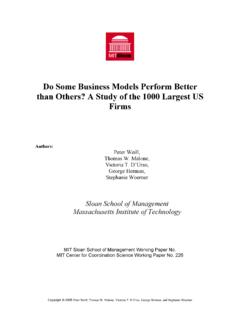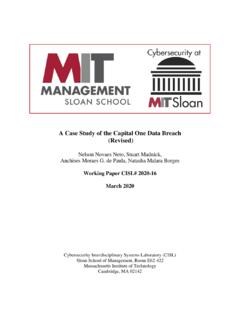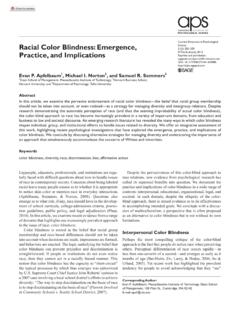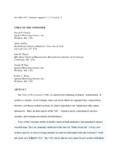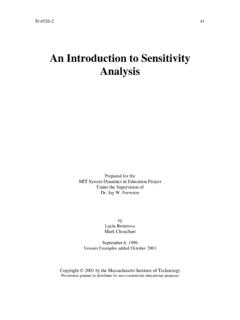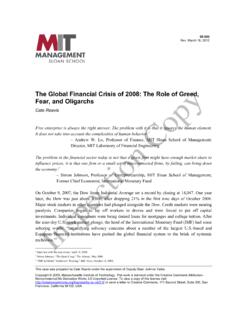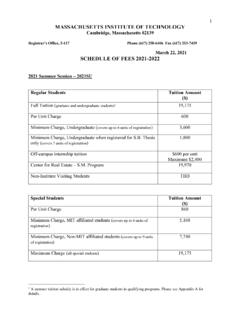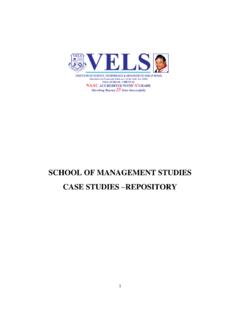Transcription of A Case Study of the Capital One Data Breach
1 A Case Study of the Capital One Data Breach Nelson Novaes Neto, Stuart Madnick, Anchises Moraes G. de Paula, Natasha Malara BorgesWorking Paper CISL# 2020-07 January 2020 Cybersecurity Interdisciplinary Systems Laboratory (CISL) sloan school of management , Room E62-422 massachusetts institute of technology Cambridge, MA 02142 1 A Case Study of the Capital One Data Breach Nelson Novaes Neto Cybersecurity at MIT sloan , sloan school of management Stuart Madnick Cybersecurity at MIT sloan , sloan school of management & MIT school of Engineering Anchises Moraes G. de Paula C6 Bank Contributor Natasha Malara Borges C6 Bank Contributor Abstract In an increasingly regulated world, with companies prioritizing a big part of their budget for expenses with cyber security protections, why have all of these protection initiatives and compliance standards not been enough to prevent the leak of billions of data points in recent years?
2 New data protection and privacy laws and recent cyber security regulations, such as the General Data Protection Regulation (GDPR) that went into effect in Europe in 2018, demonstrate a strong trend and growing concern on how to protect businesses and customers from the significant increase in cyber-attacks. Are current legislations, regulations and compliance standards sufficient to prevent further major data leaks in the future? Does the flaw lie in the existing compliance requirements or in how companies manage their protections and enforce compliance controls? The purpose of this research was to answer these questions by means of a technical assessment of the Capital One data Breach incident which occurred at one of the largest financial institutions in the This incident was selected as a case Study to understand the technical modus operandi of the attack, map out exploited vulnerabilities, and identify the related compliance requirements, that existed.
3 The National institute of Standards and technology (NIST) Cybersecurity Framework, version , as a basis for analysis because it is required by the regulatory bodies of the case Study and it is an agnostic framework widely used in the global industry to provide cyber threat mitigation guidelines. The results of this research and the case Study will help government entities, regulatory agencies, companies and managers in understanding and applying recommendations to establish a more mature cyber security protection and governance ecosystem for the protection of organizations and individuals. is nowadays one of the main enablers of digital transformation worldwide. The use of information technologies increases each year and directly impact changes in consumer behavior, development of new business models, and creation of new relationships supported by all the information underlying these interactions.
4 technology trends such as Internet of Things, Artificial Intelligence, Machine Learning, Autonomous Cars and Devices, as well as the increasing capillarity of the ever-increasing connection speed, such as 5G (Newman, 2019), result in massive production of information on behavior and privacy-related data from Novaes;Madnick;Moraes;Borges 2 everyone who is connected. More than 90% of all online data were created within the past two years (Einstein, 2019) and it is expected that these volumes will increase from 33 Zettabytes (ZB) in 2018 to 175 ZB in 2025 (Reinsel, Gantz, & Rydning, 2018). As the relationships between consumers, organizations, governments, and other entities become ever more connected, there is a tendency for consumers to become more aware of the importance and value of personal information, as well as more concerned about how these data are used by public or private entities (Panetta, 2018).
5 In order to succeed, companies need to earn and keep their client s trust, as well as follow internal values to ensure that clients consider them trustworthy. Based on numerous cyberattacks reported by the media (Kammel, Pogkas, & Benhamou, 2019), organizations are facing an increasing urgency to understand the threats that can expose their data as well as the need to understand and to comply with the emerging regulations and laws involving data protection within their business. As privacy has emerged as a priority concern, governments are constantly planning and approving new regulations that companies need to comply to protect consumer information and privacy (Gesser, et al., 2019), while the regulatory authorities throughout the world are seeking to improve transparency and responsibility involving data Breach .
6 Regulatory agencies are imposing stricter rules, they are demanding disclosure of data breaches, imposing bigger penalties for violating privacy laws, as well as using regulations to promote public policies to protect information and consumers. Despite all efforts made by regulatory agencies and organizations to establish investments and proper protection of their operations and information (Dimon), cases of data leak in large institutions are becoming more frequent and involving higher volumes of data each time. According to our research, the number of data records breached increased from billion in 2018 to over billion in 2019. There are a number of frameworks, standards and best practices in the industry to support organizations to meet their regulatory obligations and to establish robust security programs.
7 For this research, the Cybersecurity Framework version , published by the National institute of Standards and technology (NIST), a critical infrastructure resilience framework widely used by financial institutions, will be considered as a basis for compliance For the purpose of this paper, we selected bank Capital One as the object of Study due to the severity of the security incident they faced in July 2019. The main research goals and questions of this Study are: 1. Analyze the Capital One data Breach incident; 2. Based on Capital One data Breach incident - Why were compliance controls and Cybersecurity legislations insufficient to prevent the data Breach ? The result of this Study will be valuable to support executives, governments, regulators, companies and specialists in the technical understanding of what principles, techniques, and procedures are needed for the evolution of the normative standards and company s management in order to reduce the number of data Breach cases and security incidents.
8 2. Related Articles The academic literature related to the objective of this research is limited and, in some cases, outdated, with articles dating from 10 years ago and no connection with the current regulations. The cyberattack trends and the legislation related to data security and privacy have been changing frequently in the past few years. For example, the data leak cases compromising a huge amount of data (millions of data points) have become more frequent recently in the past 5 years with a recent trend towards healthcare data leakage and the exposure of huge databases stored in Cloud Computing infrastructures, without the proper access control 1 NIST published a Cybersecurity Framework in 2014 that provides guidelines to protect the critical infrastructure from cyberattacks, organized in five domains.
9 This Cybersecurity Framework is adopted by financial institutions in the to guide the information security strategy and it is formally recommended by the governance agencies, such as the Federal Financial Institutions Examination Council (FFIEC). A Case Study of the Capital One Data Breach 3 mechanisms. The frequent updates to the international rules and regulations also contribute to diminish the relevance of older studies. It is often difficult to get crucial details of the modus operandi of an attack and a list of the compliance controls that failed due to the need to not expose confidential information that could further harm the organization and increase the risk of affecting privacy policies, investigations or confidentiality laws. Furthermore, some regulatory standards do not allow disclosure of details.
10 Salane (Salane, 2009) indeed describes the great difficulty associated with studies regarding data leaks: Unfortunately, the secrecy that typically surrounds a data Breach makes answers hard to find. (..) In fact, the details surrounding a Breach may not be available for years since large scale breaches usually result in various legal actions. The parties involved typically have no interest in disclosing any more information than the law requires. In fact, it took a detailed analysis of the legal records associated with the data leaks of CardSystems Solutions in 2005 and TJX in 2007, for Salane to identify that both companies were negligent in following the security best practices and the industry s regulatory recommendations. Such records are a rich resource for research, since it provides detailed investigation on the cause of the incidents.










